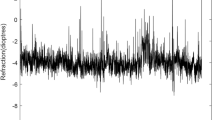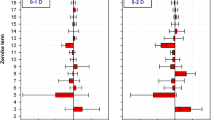Abstract
Purpose
To assess how the monocular steady-state accommodative stimulus-response curve is modified when viewing low-pass filtered natural images.
Methods
Eighteen adult subjects participated in the study. The accommodative stimulus-response curve was objectively assessed by means of a Hartmann-Shack wavefront sensor. Measurements were taken at different accommodative demands. Target images were low-pass filtered versions of a natural image that were obtained applying different digital spatial filters that limited the spatial frequency content of the natural image. Cutoff spatial frequencies were set at 30, 21, and 15 cycles per degree (cy/deg).
Results
Mean data obtained for each target were fitted to linear models. For the low-pass filtered natural image with a cutoff spatial frequency at 30 cy/deg, the slope for the averaged stimulus-response curve was 0.614, while the slopes obtained for the other two low-pass filtered images corresponding to cutoff frequencies at 21 and 15 cy/deg were 0.613 and 0.619, respectively (p < 0.01). The determination coefficient was R2 ≥ 0.988 for all targets. An ANCOVA analysis revealed that these slopes were not significantly different from each other (p = 0.82). Additionally, accommodative error indexes were obtained to measure both the discrepancy between the regression lines and the ideal lines and the degree of correlation between the stimulus and the response.
Conclusions
Our study reveals that the low and middle spatial frequencies (< 15 cy/deg) are the most important to guide to the needed levels the accommodative response to natural images.




Similar content being viewed by others
References
Kaufman PL (1992) Accommodation and presbyopia: neuromuscular and biophysical aspects. In: Adler’s physiology of the eye: clinical application. St. Louis: Mosby; pp 406–407
Culhane HM, Winn B, Gilmartin B (1999) Human dynamic closed-loop accommodation augmented by sympathetic inhibition. Invest Ophthalmol Vis Sci 40(6):1137–1143
Ward PA (1987) A review of some factors affecting accommodation. Clin Exp Optom 70(1):23–32
Ciuffreda KJ, Hokoda SC, Hung GK, Semmlow JL (1984) Accommodative stimulus/response function in human amblyopia. Doc Ophthalmol 56(4):303–326
Abbott ML, Schmid KL, Strang NC (1998) Differences in the accommodation stimulus response curves of adult myopes and emmetropes. Ophthalmic Physiol Opt 18(1):13–20
Jiang BC, White JM (1999) Effect of accommodative adaptation on static and dynamic accommodation in emmetropia and late-onset myopia. Optom Vis Sci 76(5):295–302
Charman WN, Tucker J (1977) Dependence of accommodation response on the spatial frequency spectrum of the observed object. Vis Res 17(1):129–139
Ciuffreda KJ, Hokoda SC (1983) Spatial frequency dependence of accommodative responses in amblyopic eyes. Vis Res 23(12):1585–1594
Ward PA (1987) The effect of spatial frequency on steady-state accommodation. Ophthalmic Physiol Opt 7(3):211–217
Ciuffreda KJ, Rosenfield M, Rosen J, Azimi A, Ong E (1990) Accommodative responses to naturalistic stimuli. Ophthalmic Physiol Opt 10(2):168–174
Phillips SR (1974) Ocular neurological control systems: accommodation and the near respond triad. PhD dissertation. University of California, Berkeley (USA)
Ciuffreda KJ (1991) The Glenn A. Fry invited lecture. Accommodation to gratings and more naturalistic stimuli. Optom Vis Sci 68(4):243–260
Kalloniatis M, Luu C. Visual acuity. In: Kolb H, Fernandez E, Nelson R, editors (1995) Webvision: the Organization of the Retina and Visual System. Salt Lake City (UT): University of Utah Health Sciences Center. p. 1047–1050
Thibos LN, Hong X, Bradley A, Applegate RA (2004) Accuracy and precision of objective refraction from wavefront aberrations. J Vis 4(4):329–351
Chauhan K, Charman WN (1995) Single figure indices for the steady-state accommodative response. Ophthalmic Physiol Opt 15(3):217–221
Westheimer G (2001) The Fourier theory of vision. Perception 30(5):531–541
Charman WN (1999) Near vision, lags of accommodation and myopia. Ophthalmic Physiol Opt 19(2):126–133
Wang B, Ciuffreda KJ (2006) Depth-of-focus of the human eye: theory and clinical implications. Surv Ophthalmol 51(1):75–85
Heath GG (1956) The influence of visual acuity on accommodative responses of the eye. Am J Optom Arch Am Acad Optom 33(10):513–524
Ciuffreda KJ (2006) Accommodation, the pupil, and presbyopia. In: Benjamin WJ, editor. Borish’s clinical refraction. Missouri: Butterworth-Heinemann pp. 93–144
Taylor J, Charman WN, O'Donnell C, Radhakrishnan H (2009) Effect of target spatial frequency on accommodative response in myopes and emmetropes. J Vis 9(1):14
Xu J, Zheng Z, Drobe B, Jiang J, Chen H (2015) The effects of spatial frequency on the accommodation responses of myopes and emmetropes under various detection demands. Vision Res 115(Part A):1–7
Funding
The European Research Council provided financial support in the form of the Starting Grant ERC-2012-StG-309416 funding.
Author information
Authors and Affiliations
Corresponding author
Ethics declarations
Conflict of interest
The authors declare that they have no conflict of interest.
Ethical approval
All procedures performed in studies involving human participants were in accordance with the ethical standards of the institutional and/or national research committee (name of institute/committee) and with the 1964 Helsinki declaration and its later amendments or comparable ethical standards.
Informed consent
Informed consent was obtained from all individual participants included in the study.
Rights and permissions
About this article
Cite this article
Esteve-Taboada, J.J., Bernal-Molina, P., Montés-Micó, R. et al. Accommodative stimulus-response curves to low-pass filtered natural images. Graefes Arch Clin Exp Ophthalmol 256, 1731–1737 (2018). https://doi.org/10.1007/s00417-018-3983-z
Received:
Revised:
Accepted:
Published:
Issue Date:
DOI: https://doi.org/10.1007/s00417-018-3983-z




